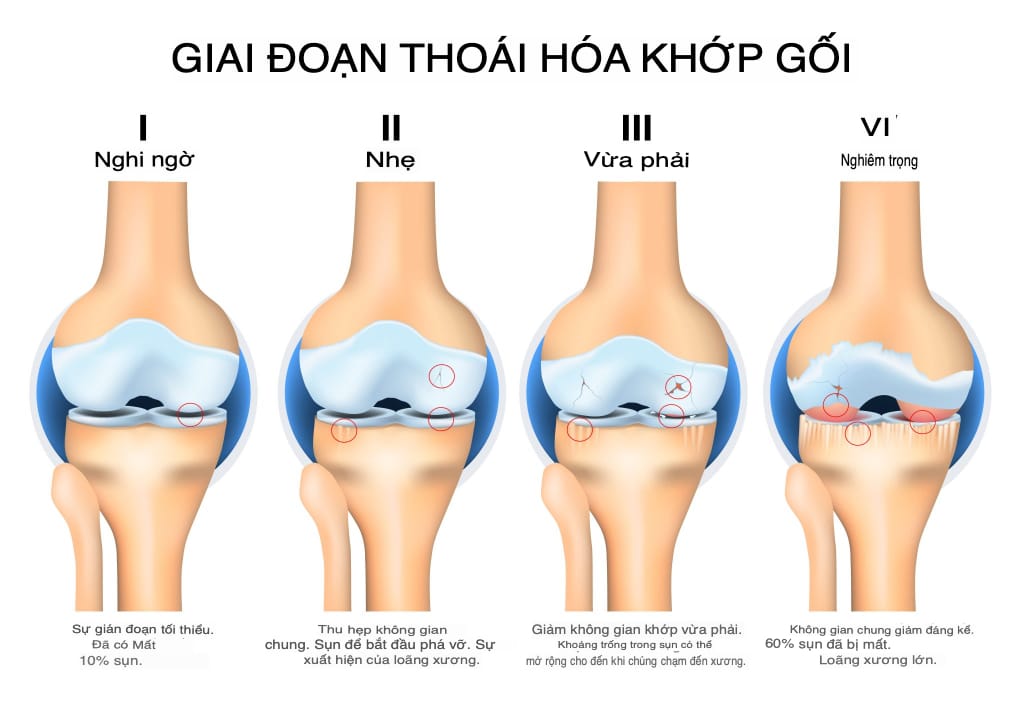Same topic
Topic “Bone and joint pain in the elderly” with you to learn the content.
Together to bring better healthcare solutions to the elderly.
-
Falls in the elderly
-
Weight loss regimen to prevent osteoarthritis?
-
Suitable diet for elderly with osteoporosis
-
Exercise regimen for people with osteoarthritis
-
How to take care of bones and joints for the elderly
-
Risk factors for osteoarthritis in the elderly
-
Weak Bones | Warning Signs and Diagnosis
-
Osteoarthritis, things not to be missed
-
Osteoporosis and what you need to know
-
Common musculoskeletal diseases
Common musculoskeletal diseases today include: arthritis, herniated disc, sciatica, gout... Musculoskeletal diseases are very diverse with more than 150 different types of diseases.
What is musculoskeletal disease?
Is a condition of weakened function of the musculoskeletal, skeletal, joint, ligament and nervous systems. The patient will experience pain, reduced mobility, causing difficulties in daily activities.

Overview of common diseases
Osteoarthritis
Common causes of osteoarthritis are age and other factors such as genetics, obesity, frequent injuries to the joints, sports accidents, etc.
Osteoarthritis often affects joints that bear weight or are frequently used by the body, such as the knee joints, lumbar spine, cervical spine, and joints in the hands. People with osteoarthritis will experience symptoms including:
Joint pain
Degenerative joints often have dull joint pain. The pain often increases with movement such as climbing stairs, bending over, etc. and the pain often decreases with rest. The pain tends to be more severe during the day than at night.
Stiffness
This symptom usually appears in the morning after waking up. The patient feels pain and difficulty moving the degenerated joints.
The duration of joint stiffness usually lasts <30 minutes. After that, the degenerated joint will gradually become less stiff and return to normal movement.
Creaking when moving joints
Degenerative joints will have a decrease in synovial fluid in the joint. This synovial fluid has the function of lubricating and reducing friction between the two ends of the bone when the joint moves. Therefore, degenerative joints will have a creaking, crackling phenomenon when moving the joint. 
especially at the knee joint when climbing stairs or squatting.
- Joint deformity: Making the patient's legs not straight can cause deformity. bow legs or X-shaped leg deformity. Some bone deformities in the hands such as misaligned metacarpophalangeal joints, the appearance of raised masses in the hands especially in the fingers.
Spinal disc herniation
Also known as a lumbar disc herniation, the condition occurs when a disc in the spine slips out of its normal position and puts pressure or damage on nearby nerves.
This can cause a variety of symptoms and problems, including:
Pain usually occurs in the back or neck, depending on the location of the herniated disc. Pain may radiate to the thigh, buttocks, leg, or arm.
Decreased function, loss of sensation, or weakness in the affected area. A herniated cervical disc can cause numbness and weakness in the neck, shoulders, and arms.
Reduced flexibility and mobility of the affected area. Difficulty performing daily activities such as bending, stooping, walking or lifting heavy objects.
Some cases of disc herniation can cause inflammation around the affected area, leading to swelling, redness, and another inflammatory response.
Gout
The main cause of the disease is a metabolic disorder related to diet due to high uric acid levels leading to the deposition of urate crystals (salts of uric acid) in the joints, tendons and surrounding tissues.
Symptoms of Gout are as follows:
- Sudden, severe joint pain and swelling
- Joints hurt more when touched
- Red and swollen joints
- Warm area around the joint
Most gout symptoms usually last for a few hours to 1-2 days. However, in severe cases, the pain can last for several weeks.
Sciatica
This is a condition in which pain radiates from the buttocks down the path of the sciatic nerve. Causes of sciatica include:
Herniated disc
This is the most common cause. The bulging disc behind the disc puts pressure on the sciatic nerve.
Lumbar spine degeneration
Degenerative conditions cause bone spurs to form, encroaching on the spinal foramen, where the sciatic nerve exits the spine.
Large enough bone spurs can press on the sciatic nerve, causing pain. Some degenerative conditions that narrow the spinal canal can also cause pain.
Spondylolisthesis
Spondylolisthesis narrows the spinal foramen, affecting the sciatic nerve, causing pain. Other causes of sciatica include trauma, inflammation, etc.
Spinal stenosis
Also known as spinal stenosis is a condition in which the space inside the spinal canal is narrowed, causing pressure on the nerve roots and spinal cord passing through the spine. The spinal canal is a hollow space formed by the vertebrae stacked on top of each other to form a small tube, which plays a role in protecting the spinal cord and nerve roots.
Spinal stenosis can appear at any age, but Most common in women over 50 years old. As the disease progresses, it can cause numbness, weakness in the limbs, and affect balance.
Some cases of spinal stenosis cause severe nerve compression, which can lead to loss of bladder and bowel control, urinary disorders, paralysis, etc.
Osteoporosis
Also known as brittle bone disease or osteoporosis, the cause is the phenomenon of bones continuously thinning and bone density becoming increasingly sparse, making bones more brittle, vulnerable and prone to fracture even with only minor trauma.

- Symptoms of osteoporosis are often unclear. Many cases are only discovered when there are signs of bone fractures...
- Bone pain: the patient will feel tired along the long bones, even pain like being pricked by needles all over the body.
- Pain in the bones that bear the body's weight regularly such as: spine, waist, pelvis, hip bones, knees, recurring pain after injury, the pain is often dull and lasts a long time
- The pain will increase when moving, walking, standing or sitting for a long time and will be relieved when lying down.
- People with signs of osteoporosis often have difficulty performing postures such as bending over or turning completely.
Scoliosis
Scoliosis is an abnormal curvature of the spine, the curve can be forward or backward (kyphosis), the spine deviates to one side (curvature of the spine); depending on the cause of the disease in each person. This is a type of disease that can improve gradually over time.
In cases of mild scoliosis that does not affect daily activities or seriously affect physical health, patients only need to perform gentle back exercises to improve and gradually restore the condition over time.
Although the disease rarely causes painful symptoms, it can significantly affects spinal degenerationTherefore, for adults, the top concern is that the process of bone degeneration in the lumbar and sacral vertebrae will occur earlier and faster than normal.
Bone tumor
Primary bone cancer originates from bone components: osteoblasts, chondroblasts, and bone connective tissue cells. The disease is highly malignant and metastasizes early. Bone cancer can be primary or metastatic from other sites (mainly from the breast, lung, etc.)
The disease is common in adolescents, especially those aged 10-14, accounting for 80%. The second peak of the disease occurs at age 50-60.. At this stage there are strong changes in the musculoskeletal system.
Risk factors for primary bone cancer include:
- Genetics: Having a family member with Li-Fraumeni syndrome, Rothmund-Thomson syndrome, retinoblastoma, etc.
- Paget's disease of bone: caused by a disorder of bone formation and bone destruction leading to the formation of new bone tissue with an abnormal structure.
Rheumatoid arthritis
Rheumatoid arthritis is a chronic autoimmune inflammatory condition of the joints. It occurs when the immune system attacks the tissue surrounding the joints called the synovial membrane.
The disease affects many joints and can also affect other tissues and organs of the body. Symptoms of rheumatoid arthritis include:
- Painful and stiff joints
- Swollen joints
- Limited joint mobility
- Redness around the joint
- Morning stiffness that lasts for an hour or more
- Low notes appear
- Symmetrical joint damage
- Damage to small joints of hands and feet
Conclusion
Most musculoskeletal diseases are difficult to cure completely, and may even require surgery. Therefore, you should take preventive measures such as:
- Establish a nutritional regimen supplemented with calcium-rich foods
- Exercise regimen: Every day, you should do light exercises such as yoga, walking, jogging, etc. to protect your musculoskeletal health.
- Living and working regimen: You need to constantly change your posture, avoid sitting or standing for too long, limit overwork, and take plenty of rest time.
- Control your weight: Obesity can damage your joints because of the pressure on your joints. You should maintain a healthy weight to reduce the stress on your joints.
Are you looking for home or facility-based care?
Hio is a pioneering platform providing comprehensive and personalized elderly care services at home and medical facilities. No additional costs, change caregivers without additional costs, immediate refund if customers are not satisfied, care information is continuously updated to ensure peace of mind for families.





